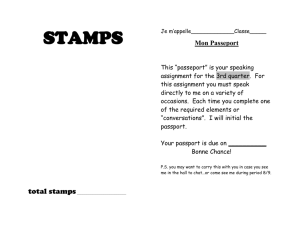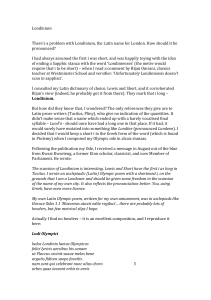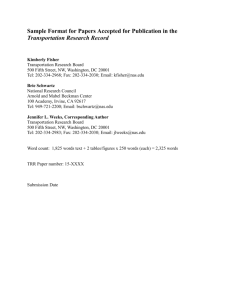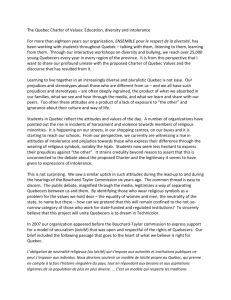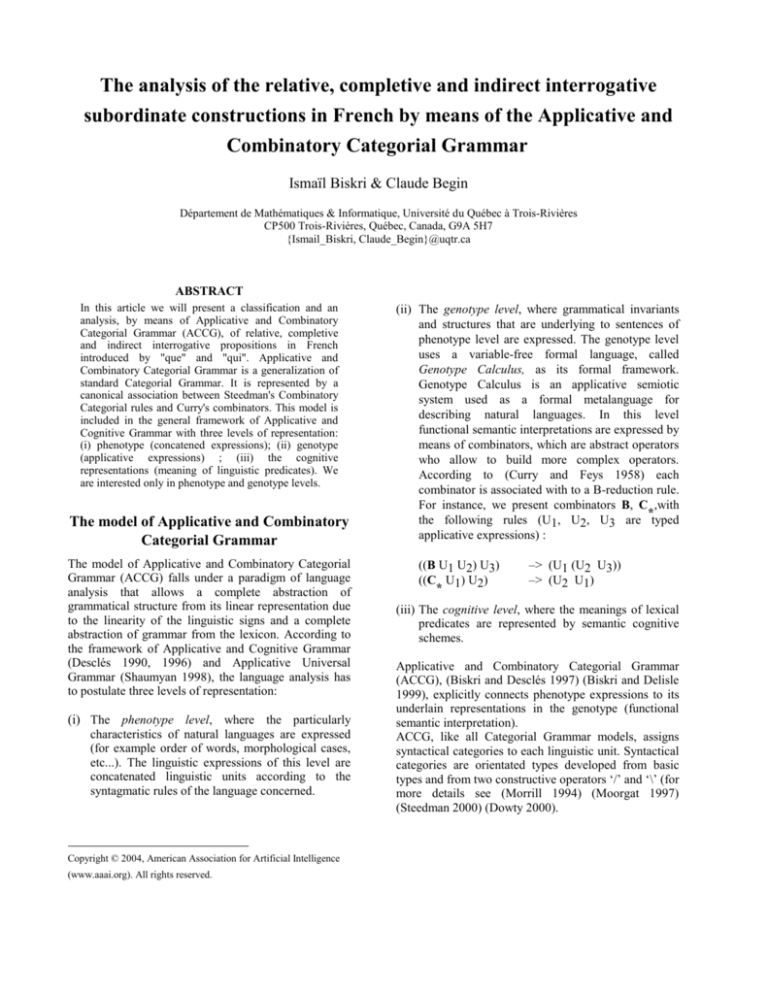
The analysis of the relative, completive and indirect interrogative
subordinate constructions in French by means of the Applicative and
Combinatory Categorial Grammar
Ismaïl Biskri & Claude Begin
Département de Mathématiques & Informatique, Université du Québec à Trois-Rivières
CP500 Trois-Rivières, Québec, Canada, G9A 5H7
{Ismail_Biskri, Claude_Begin}@uqtr.ca
ABSTRACT
In this article we will present a classification and an
analysis, by means of Applicative and Combinatory
Categorial Grammar (ACCG), of relative, completive
and indirect interrogative propositions in French
introduced by "que" and "qui". Applicative and
Combinatory Categorial Grammar is a generalization of
standard Categorial Grammar. It is represented by a
canonical association between Steedman's Combinatory
Categorial rules and Curry's combinators. This model is
included in the general framework of Applicative and
Cognitive Grammar with three levels of representation:
(i) phenotype (concatened expressions); (ii) genotype
(applicative expressions) ; (iii) the cognitive
representations (meaning of linguistic predicates). We
are interested only in phenotype and genotype levels.
The model of Applicative and Combinatory
Categorial Grammar
The model of Applicative and Combinatory Categorial
Grammar (ACCG) falls under a paradigm of language
analysis that allows a complete abstraction of
grammatical structure from its linear representation due
to the linearity of the linguistic signs and a complete
abstraction of grammar from the lexicon. According to
the framework of Applicative and Cognitive Grammar
(Desclés 1990, 1996) and Applicative Universal
Grammar (Shaumyan 1998), the language analysis has
to postulate three levels of representation:
(i) The phenotype level, where the particularly
characteristics of natural languages are expressed
(for example order of words, morphological cases,
etc...). The linguistic expressions of this level are
concatenated linguistic units according to the
syntagmatic rules of the language concerned.
Copyright © 2004, American Association for Artificial Intelligence
(www.aaai.org). All rights reserved.
(ii) The genotype level, where grammatical invariants
and structures that are underlying to sentences of
phenotype level are expressed. The genotype level
uses a variable-free formal language, called
Genotype Calculus, as its formal framework.
Genotype Calculus is an applicative semiotic
system used as a formal metalanguage for
describing natural languages. In this level
functional semantic interpretations are expressed by
means of combinators, which are abstract operators
who allow to build more complex operators.
According to (Curry and Feys 1958) each
combinator is associated with to a B-reduction rule.
For instance, we present combinators B, C ,with
*
the following rules (U1, U2, U3 are typed
applicative expressions) :
((B U1 U2) U3)
((C U1) U2)
*
–> (U1 (U2 U3))
–> (U2 U1)
(iii) The cognitive level, where the meanings of lexical
predicates are represented by semantic cognitive
schemes.
Applicative and Combinatory Categorial Grammar
(ACCG), (Biskri and Desclés 1997) (Biskri and Delisle
1999), explicitly connects phenotype expressions to its
underlain representations in the genotype (functional
semantic interpretation).
ACCG, like all Categorial Grammar models, assigns
syntactical categories to each linguistic unit. Syntactical
categories are orientated types developed from basic
types and from two constructive operators ‘/’ and ‘\’ (for
more details see (Morrill 1994) (Moorgat 1997)
(Steedman 2000) (Dowty 2000).
(i) N (nominal syntagm) and S (sentence) are basic
types.
(ii) (ii) If X and Y are orientated types then X/Y and
X\Y are orientated types. According to Steedman's
notation (2000), X/Y and X\Y are functional
orientated types. A linguistic unit 'u' with the type
X/Y (respectively X\Y) is considered as operator
(or function) whose typed operand Y is positioned
on the right (respectively on the left) of operator.
Application rules :
[X/Y : u1] - [Y : u2]
---------------------------->
[X : (u1 u2)]
Type-raising rules :
[X : u]
------------------------>T
[Y/(Y\X) : (C u)]
*
In our paper, a linguistic unit u with orientated type X
will be designed by ‘[X : u]’.
Let us provide now ACCG rules used in this paper. To
see the whole of the rules the reader might have a look
on (Biskri and Desclès, 1997) :
;
[Y : u1] - [X\Y : u2]
--------------------------<
[X : (u2 u1)]
[X/Y : u1]-[Y/Z : u2]
composition rules Functional: ------------------------->B
[X/Z : (B u1 u2)]
The premises in each rule are concatenations of linguistic
units with orientated types considered as being operators or
operands, the consequence of each rule is an applicative
typed expression with an eventual introduction of one
combinator. The type-raising of an unit u introduces the
combinator C ; the composition of two concatened units
*
introduces the combinator B and S.
Let us deal with a simple example:
La liberté renforce la démocratie (Freedom reinforces democracy)
1.
2.
3.
4.
5.
6.
[N/N : la]-[N : liberté]-[(S\N)/N : renforce]-[N/N : la]-[N : démocratie]
[N : (la liberté)]-[(S\N)/N : renforce]-[N/N : la]-[N : démocratie]
[S/(S\N):(C* (la liberté))]-[(S\N)/N: renforce]-[N/N: la]-[N: démocratie]
[S/N : (B (C* (la liberté)) renforce)]-[N/N : la]-[N : démocratie]
[S/N : (B (B (C* (la liberté)) renforce) la)]-[N : démocratie]
[S : ((B (B (C* (la liberté)) renforce) la) démocratie)]
7. [S : ((B (B (C* (la liberté)) renforce) la) démocratie)]
8. [S : ((B (C* (la liberté)) renforce) (la démocratie))]
9. [S : ((C* (la liberté)) (renforce (la démocratie)))]
10. [S : ((renforce (la démocratie)) (la liberté)))]
11. [S : renforce (la démocratie) (la liberté)]
The first step consists in assigning syntactic types to the
lexical units. Those are entries of a dictionary where each
unit is associated to one or more types.
Steps 2 to 6 consist in operating the rules of the ACCG in
the way to check the syntactic correctness on the one hand
and progressively to build the predicative structures by the
introduction of combinators with the syntactic process.
Thus, step 2 consists in applying the rule (>) to the
linguistic units: la and liberté. The subject la liberté is then
built. The third step sees the introduction of the combinator
C*. Applied to the operand la liberté, C* makes it possible
to build an operator (C* (la liberté)) that we compose at
(>)
(>T)
(>B)
(>B)
(>)
B
B
C*
step 4 with the operator renforce with using the rule (>B)
the
result
is
a
more
complex
operator
(B (C* (la liberté)) renforce). This last operator is
composed in step 5 with la. Step 6 is the application of the
operator (B (B (C* (la liberté)) renforce) la) to the
operand démocratie. Steps 1 to 6 occur in the phenotype.
Obtaining the type S at step 6 guarantees the syntactic
correctness of the statement. Steps 7 to 11 are a natural
deduction in the genotype, which consists in eliminating
the combinators according to the B-reduction rules shown
previously. The predicative structure of the genotype level
obtained at the step 11 : renforce (la démocratie) (la liberté),
represents the functional semantic interpretation of the given
sentence : la liberté renforce la démocratie.
With such a model, we have analysed in previous works
many complex constructions like coordination, sentences
with backward modifiers, etc. In this paper we will present
the analysis of relative, completive and indirect
interrogative constructions in French.
The relative, completive and indirect
interrogative constructions in French and the
ACCG
The concept of relation between two sentences is
significant in the case of the French subordinate clauses,
since subordination is a syntactic relation of dependence
between linguistic units. The subordinate clause always
depends from another proposition. It should be noted that
the category of the subordinate clauses is not well defined
in French, since certain propositions which do not have any
syntactic dependence relation with another proposition are
classified as subordinate clauses. The problem of our
research is formulated as follows: How are the subordinate
relative, completive and indirect interrogative clauses
categorised in order to support the automatic processing of
the natural languages? We wanted to analyze at the same
time relative, completive and indirect interrogative
propositions because their categories share the same
syntactic structures and occupy sometimes similar syntactic
functions in speech. The analysis was made on a corpus
which gathers more than one hundred of different
propositions. However, in our article, we will limit
ourselves for practical reasons to the following
propositions:
Qui m’aime me suive (who loves me has to follow
me) : relative proposition
ii) Que tu m’aimes me réjouit (that you love me, delights
me) : completive proposition
iii) J’aime la personne qui m’aime (i love the person who
loves me) : relative proposition
iv) J’aime qui tu aimes (i love whom you love) : relative
proposition
v) J’aime que tu viennes (i love that you come)
completive proposition
vi) Pierre aime qui l’aime (Pierre loves who loves him) :
relative proposition
vii) Pierre se demande qui l’aime (Pierre wonders who
loves him) : indirect interrogative proposition
viii) La femme que tu vois est ma sœur (the woman that
you see is my sister) : relative proposition
ix) La femme qui vient est ma sœur (the woman who
comes is my sister) : relative proposition
x) Le scientifique parle de l'objet que Pierre trouva
(The scientist speaks about the object which Pierre
found) : relative proposition
i)
xi)
xii)
xiii)
xiv)
xv)
La robe que tu vends intéresse cette cliente (The
dress that you sell interests this customer). : relative
proposition
L'officier, qui donne les ordres, a déposé son fusil
(The officer, who gives the orders, deposited his
rifle). : relative proposition
Heureux qui frissonne aux miracles de cette poésie
(Happy who shivers with the miracles of this poetry).
: relative proposition
Il écrase qui ne lui obéit (He crushes who does not
obey to him). : relative proposition
Pierre entend le voisin qui chante (Pierre hears the
neighbour who sings). : relative proposition
A subordinate clause is a proposition which depends on a
main clause and which is often attached to it by a
subordinating conjunction, a relative pronoun, a relative
adjective, an interrogative pronoun or an interrogative
adjective. However, certain syntagms which do not have
any relation of dependence and which are thus not
subordinate clauses are classified in this category. The
phenomenon can be observed for relative and completive
syntagms which occupy, for instance, the function of
grammatical subject. In the sentence i, the relative clause
qui m’aime is the subject of the verb suive.
In the sentence ii, que tu viennes is the subject of the verb
réjouit.
[Qui m’aime]N me suive
[Que tu m’aimes]N me réjouit
The subject cannot be logically subordinate to the verb.
The classification of the relative and completive clauses
under the category of subordination as presented in
Handbooks of Grammar like Grévisse (1991) is not
conform to grammatical reality as it is observed in the two
preceding examples. AS for them, the indirect interrogative
propositions are subordinate clauses which are introduced
by a verb introducer expressing the interrogation and an
interrogative word such as qui, quand, comment. There are
two types of relative clauses and two types of indirect
interrogative propositions: the propositions which are
introduced by an antecedent and the propositions which do
not have any antecedent.
Thus, the relative clause qui m’aime in the sentence i do
not have any antecedent, whereas, in the sentence iii, the
relative clause qui m’aime, has an antecedent, the word
personne of which it is a backward modifier.
J’aime la [personne]N [qui m’aime]N\N
It is possible to propose a classification, according the
ACCG model, which respects the structure of this study’s
propositions. The analysis of various relative, completive
and indirect interrogative clauses presented here shows that
they often share common syntactic structures, and,
different nouns were frequently used to identify similar
syntactic constructions. For instance, sentences iv and v
have similar structures: subject + verb + object.
[J’]N [aime](S\N)/N [qui tu aimes]N
[J’]N [aime](S\N)/N [que tu viennes]N
The propositions qui tu aimes and que tu viennes are are
classified in different categories, that is to say respectively
in the category of the relative clauses and the category of
the completive clauses. The principal difference is that the
two propositions have not the same referent.
The operators being used to build the relative clauses and
the completive clauses in French can be divided into two
main categories: (i) “builders” of nouns; (ii) “builders” of
modifiers. The true distribution of the relative, completive
and indirect interrogative propositions is done under these
two categories. It is noticed that these propositions act in
the same way that substantives or adjectives. The
propositions which are built with a «builder» of noun can
be subjects, attributes, direct objects, indirect objects,
whereas the propositions which are built with a “builder”
of modifiers often act like adjectives, and even sometimes
like adverbs. The propositions can achieve in syntax the
same functions as the linguistic units which make it
possible to form the language such as the substantives and
the adjectives.
In the sentences i and ii, qui and que are “builders” of
nouns. The difference between the proposition qui l’aime
in sentences vi and vii is the meaning of the verb who
introduces this proposition.
Pierre aime [qui l’aime]N
Pierre se demande [qui l’aime]N
In the sentences viii and ix, qui and que are “builders” of
modifiers. The syntagms que tu vois and qui vient are both
modifiers of the syntagm la femme.
La [femme]N [que tu vois]N\N est ma sœur
La [femme]N [qui vient]N\N est ma sœur
As it is possible to note it, the difference is not relatively to
a syntactic criterion, but to a semantic criterion (Girard,
2001). In addition, the classification of qui (relative and
interrogative pronoun cases) and of que (completive cases)
as «builder» of noun is justified by the fact that the two
operators allow the construction of syntagms referring a
part of reality (an object entity): qui m’aime, qui vient, qui
pense… The difference between the two is that qui
(relative and interrogative pronoun cases) makes it possible
to refer people, whereas que (completive cases) references
a verbal action or a state indication: que tu m’aimes, que
tu viennes, que tu penses… The qui in interrogative cases
can also be a «builder» of noun: the proposition that it used
to build can however be only object of the verb.
The relative and completive clauses "builders of nouns"
can occupy a multitude of functions in the sentence:
subject, direct object, indirect object, attribute. Their
“versatility” can easily be compared with certain noun
phrases such une pomme, une fille, un homme… We can
consequently easily replace propositions by linguistic units
of different meanings but of the same syntactic structure.
By this observation we notice that the language generalizes
its behaviour to the whole of the units that constitute it,
since noun phrases and propositions as complex as relative
and completive clauses can occupy similar functions in
speech.
It should however be mentioned that there is a principal
difference between the relative clauses and the completive
clauses "builders of nouns": the concept of quantification.
Thus, the sentences Qui m’aime me réjouit and Que tu
m’aimes me réjouit contain a major difference in their
meaning: Qui m’aime can be interpreted by all those who
like me and it becomes introducer of a universal
quantification on a set containing the persons who like me,
whereas Que tu m’aimes introduces only the fact that you
like me.
What must retain our attention remains the fact that the
pronouns que and qui are perceived as operators who
attach what we will call anyway the subordinate
proposition to the main proposition. That is what assumes
traditional Grammar. With Categorial Grammars, this
aspect of the pronouns is included in the syntactic
categories assigned to them. Each syntactic category
reflects the way in which the pronoun will operate on both
of the main and the subordinate propositions to attach
them. Thus, in (x) as in (xi) and in (viii) the pronoun que,
after being applied to a "NP-Verb" proposition ([Pierre]NP
[trouva]Verb), modifies a Noun ([objet]Noun) in order to give
a complex Noun ([objet que Pierre trouva] Noun. We can
assign the category (N\N)/(S/N) to the pronoun que.
In (xii) as in (ix) the pronoun qui, after being applied to a
"Verb-NP" proposition ([donne]Verb [les ordres]NP),
modifies a Noun ([officier]Noun) in order to give a complex
Noun ([officier, qui donne les ordres]Noun. We can assign
the category (N\N)/(S\N) to the pronoun qui.
In (i) as in (xiii) and in (xiv) qui, is applied to an
intransitive verb (m'aime in (i), frissonne aux miracles de
cette poésie in (xiii), ne lui obéit in (xiv)) which category is
S\N in order to contruct a noun (qui m'aime in (i), qui
frissonne aux miracles de cette poésie in (xiii), ne lui obéit
in (xiv)). Thus, here, we can assign the category N/(S\N) to
the pronoun qui. This category reflects the universal
quantification nature of the pronoun qui in what we will
call substantive subordinate constructions.
We summarize the whole of possible categories assigned to
que and qui in the following table:
Noun builder
J’aime qui tu aimes
Qui vivra verra
Modifier builder
(N\N)/(S/N)
La femme que tu vois est ma
sœur
(N\N)/(S\N)
La femme qui vient est ma soeur
Table 1 : table of categories of the syntactic types of the
relative clauses.
N/(S/N)
N/(S\N)
Noun builder
J’aime que tu viennes
Modifier builder
(N\N)/S
L’espoir que tu viennes me réjouit
Table 2 : table of categories of the syntactic types of the
completive clauses.
N/S
Let us now deal with certain analysis (many other examples
have been processed)
a) L'officier, qui donne les ordres, a déposé son fusil
1.
2.
3.
4.
5.
6.
7.
8.
9.
[N/N:l'] - [N:officier] - [(N\N)/(S\N):qui] - [(S\N)/N:donne] - [N: (les ordres)] - [(S\N)/(S\N):a] - [(S\N)/N:déposé] - [N: (son fusil)]
[N/N:l'] - [N:officier] - [(N\N)/N: (B qui donne)] - [N: (les ordres)] - [(S\N)/(S\N):a] - [(S\N)/N:déposé] - [N: (son fusil)]
(>B)
[N/N:l'] - [N:officier] - [N\N : ((B qui donne) (les ordres))] - [(S\N)/(S\N):a] - [(S\N)/N:déposé] - [N: (son fusil)]
(>)
[N/N:l'] - [N : (((B qui donne) (les ordres)) officier)]- [(S\N)/(S\N):a] - [(S\N)/N:déposé] - [N: (son fusil)]
(<)
[N: (l' (((B qui donne) (les ordres)) officier))]- [(S\N)/(S\N):a] - [(S\N)/N:déposé] - [N: (son fusil)]
(>)
[S/(S\N) : (C* (l' (((B qui donne) (les ordres)) officier)))]- [(S\N)/(S\N):a] - [(S\N)/N:déposé] - [N: (son fusil)]
(>T)
[S/(S\N) : (B (C* (l' (((B qui donne) (les ordres)) officier))) a)] - [(S\N)/N:déposé] - [N: (son fusil)]
(>B)
[S/N : (B (B (C* (l' (((B qui donne) (les ordres)) officier))) a) déposé)] - [N: (son fusil)]
(>B)
[S : ((B (B (C* (l' (((B qui donne) (les ordres)) officier))) a) déposé) (son fusil))]
(>)
10.
11.
12.
13.
14.
((B (B (C* (l' (((B qui donne) (les ordres)) officier))) a) déposé) (son fusil))
(B (C* (l' (((B qui donne) (les ordres)) officier))) a) (déposé (son fusil))
(C* (l' (((B qui donne) (les ordres)) officier))) (a (déposé (son fusil)))
(a (déposé (son fusil))) (l' (((B qui donne) (les ordres)) officier))
(a (déposé (son fusil))) (l' ((qui (donne (les ordres))) officier))
B
B
C*
B
b) Qui vivra verra
1.
2.
3.
[N/(S\N) :qui] - [S\N : vivra] - [S\N : verra]
[N : (qui vivra)] - [S\N : verra]
[S : (verra (qui vivra))]
4.
(verra (qui vivra))
(>)
(>)
c) Heureux qui frissonne aux miracles de cette poésie
1.
2.
3.
4.
5.
6.
7.
8.
[N/N:heureux] - [N/(S\N):qui] - [S\N:frissonne] - [((S\N)\(S\N))/N:aux] - [N:miracles] - [(N\N)/N:de] - [N/N:cette] - [N:poésie]
[N/N:heureux] - [N/(S\N):qui] - [S\N:frissonne] - [((S\N)\(S\N))/N:aux] - [N:miracles] - [(N\N)/N:de] - [N : (cette poésie)] (>)
[N/N:heureux] - [N/(S\N):qui] - [S\N:frissonne] - [((S\N)\(S\N))/N:aux] - [N:miracles] - [N\N : (de (cette poésie))]
(>)
[N/N:heureux] - [N/(S\N):qui] - [S\N:frissonne] - [((S\N)\(S\N))/N:aux] - [N : ((de (cette poésie)) miracles)]
(<)
[N/N:heureux] - [N/(S\N):qui] - [S\N:frissonne] - [(S\N)\(S\N) : (aux ((de (cette poésie)) miracles))]
(>)
[N/N:heureux] - [N/(S\N):qui] - [S\N : ((aux ((de (cette poésie)) miracles)) frissonne)]
(<)
[N/(S\N) : (B heureux qui)] - [S\N : ((aux ((de (cette poésie)) miracles)) frissonne)]
(>B)
[N : ((B heureux qui) ((aux ((de (cette poésie)) miracles)) frissonne))]
(>)
9.
10.
((B heureux qui) ((aux ((de (cette poésie)) miracles)) frissonne))
(heureux (qui ((aux ((de (cette poésie)) miracles)) frissonne)))
B
d) Pierre entend le voisin qui chante
1.
2.
3.
4.
5.
6.
7.
[N:pierre] - [(S\N)/N:entend] - [N/N:le] - [N:voisin] - [(N\N)/(S\N):qui] - [S\N:chante]
[S/(S\N) : (C* Pierre)] - [(S\N)/N:entend] - [N/N:le] - [N:voisin] - [(N\N)/(S\N):qui] - [S\N:chante]
[S/N : (B (C* Pierre) entend)] - [N/N:le] - [N:voisin] - [(N\N)/(S\N):qui] - [S\N:chante]
[S/N : (B (B (C* Pierre) entend) le)] - [N:voisin] - [(N\N)/(S\N):qui] - [S\N:chante]
[S/N : (B (B (C* Pierre) entend) le)] - [N:voisin] - [(N\N) : (qui chante)]
[S/N : (B (B (C* Pierre) entend) le)] - [N : ((qui chante) voisin)]
[S : ((B (B (C* Pierre) entend) le) ((qui chante) voisin))]
8. ((B (B (C* Pierre) entend) le) ((qui chante) voisin))
9. (B (C* Pierre) entend) (le ((qui chante) voisin))
10. (C* Pierre) (entend (le ((qui chante) voisin)))
11. ((entend ((qui chante) (le voisin))) pierre)
(>T)
(>B)
(>B)
(>)
(<)
(>)
B
B
C*
e) J’aime que tu viennes
1.
2.
3.
4.
5.
6.
[N : Je] – [(S\N)/N : aime] - [N/S : que] – [N : tu] - [(S\N) : viennes]
[S/(S\N) : (C* Je)] – [(S\N)/N : aime] - [N/S : que] – [N : tu] - [(S\N) : viennes]
[S/N : (B (C* Je) aime)] - [N/S : que] – [N : tu] - [(S\N) : viennes]
[S/S : (B (B (C* Je) aime) que)] – [N : tu] - [(S\N) : viennes]
[S/S : (B (B (C* Je) aime) que)] – [S : (viennes tu)]
[S : ((B (B (C* Je) aime) que) (viennes tu))]
(>T)
(>B)
(>B)
(<)
(>)
7.
8.
9.
10.
((B (B (C* Je) aime) que) (viennes tu))
(B (C* Je) aime) (que (viennes tu))
(C* Je) (aime (que (viennes tu)))
((aime (que (viennes tu))) Je)
B
B
C*
Conclusion
The classification and the analysis of relative, completive
and indirect interrogative propositions in French by means
of Applicative and Combinatory Categorial Grammar
(ACCG) make it possible to simplify the models treating of
the propositions and to highlight the mechanisms used in
the French language such as the use of the functions. The
French language applies its system of function to the
system of the propositions. It can thus create the major part
of the sentences with a limited set of functions: subject,
direct object, indirect object, attribute... The emphasis put
on that relative, completive and indirect interrogative
propositions are divided, in fact, in a binary system
(“builders” of nouns and “builders” of modifiers), we
highlight that the language integrates propositions as
complex as relative, completive and indirect interrogative
propositions in its system of the parts of speech in order to
support the integration of these syntagms formed in a
complex sentence. Such an analysis has the merit to
simplify the syntactic model while emphasizing the
common elements of the language. The traditional
classification of the relative, completive and indirect
interrogative propositions results from a confusion between
syntax and semantics. The ACCG makes it possible to
carry out a classification of the syntactic units which
emphasizes the syntactic structure of the French language
making it possible to work out thereafter a modeling on
three levels: phenotype, genotype, cognitive representation.
The present study was limited to the analysis of qui and
que in French. The results of the analysis are however
promising. Next studies on the relative, completive and
indirect interrogative propositions in French could be
broader and could relate to other propositions, such as
those introduced by dont, auquel, comment, etc.
References
Biskri, I., Delisle, S., 1999, Les Grammaires Catégorielles
pour le développement d'applications multilingues
destinées au WEB, Revue BULAG, Numéro spécial sur le
Génie Linguistique et le Génie Informatique, Besançon,
France.
Biskri, I., Desclés, J.P., 1997, Applicative and
Combinatory Categorial Grammar (from syntax to
functional semantics). In Recent Advances in Natural
Language Processing, 71-84. John Benjamins Publishing
Company.
Curry, B. H., Feys, R., 1958. Combinatory logic , Vol. I,
North-Holland.
Desclés, J.P., 1996. Cognitive and Applicative Grammar:
an Overview. in C. Martin Vide, ed. Lenguajes Naturales y
Lenguajes Formales, XII, Universitat Rovra i Virgili. , 2960.
Desclés, J. P, 1990. Langages applicatifs, langues
naturelles et cognition, Hermes, Paris.
Dowty,
D.,
2000,
The
Dual
Analysis
of
Adjuncts/Complements in Categorial Grammar. In
Linguistics 17.
Girard, G., 2001, Les fausses interrogatives. In
proceedings of the conference Sémantique Syntaxe et
Linguistique Anglaises. Paris
Moorgat, M., 1997. Categorial Type Logics. In Johan Van
Benthem and Alice Ter Meulen eds., Handbook of Logic
and Language, 93-177. Amsterdam: North Holland.
Morrill, G., 1994, Type-Logical Grammar. Dordrecht:
Kluwer.
Shaumyan, S. K., 1998. Two Paradigms Of Linguistics:
The Semiotic Versus Non-Semiotic Paradigm. In Web
Journal of Formal, Computational and Cognitive
Linguistics.
Steedman, M., 2000. The Syntactic Process, MIT
Press/Bradford Books.

